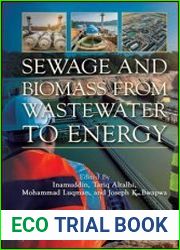
BOOKS - Sewage and Biomass from Wastewater to Energy Possibilities and Technology

Sewage and Biomass from Wastewater to Energy Possibilities and Technology
Author: Tariq Altalhi, Joseph K. Bwapwa
Year: 2024
Pages: 440
Format: PDF
File size: 53,6 МБ
Language: ENG

Year: 2024
Pages: 440
Format: PDF
File size: 53,6 МБ
Language: ENG

The book "Sewage and Biomass from Wastewater to Energy Possibilities and Technology" explores the potential of using sewage and biomass from wastewater to produce energy, highlighting the latest advancements in this field. The author emphasizes the importance of understanding the technology's development process and its impact on society, as well as the need for a personal paradigm shift in how we perceive technological progress. The book begins by examining the current state of wastewater treatment and the challenges it faces, including the disposal of sludge and the release of pollutants into the environment. It then delves into the concept of harnessing sewage and biomass as a source of renewable energy, discussing the various methods of doing so, such as anaerobic digestion, gasification, and pyrolysis. These processes are explained in detail, taking into account their advantages and limitations. The author also explores the potential of using wastewater-derived biomass as a feedstock for biofuels, highlighting the benefits of this approach, such as reducing greenhouse gas emissions and providing a sustainable alternative to fossil fuels. Additionally, the book discusses the role of policy and regulation in promoting the use of wastewater-derived energy, as well as the economic and environmental benefits of implementing these technologies.
В книге «Сточные воды и биомасса от сточных вод к энергетическим возможностям и технологиям» рассматривается потенциал использования сточных вод и биомассы из сточных вод для производства энергии, освещаются последние достижения в этой области. Автор подчеркивает важность понимания процесса развития технологии и ее влияния на общество, а также необходимость персональной смены парадигмы в том, как мы воспринимаем технологический прогресс. Книга начинается с изучения текущего состояния очистки сточных вод и проблем, с которыми она сталкивается, включая утилизацию ила и выброс загрязняющих веществ в окружающую среду. Затем он углубляется в концепцию использования сточных вод и биомассы в качестве источника возобновляемой энергии, обсуждая различные методы этого, такие как анаэробное пищеварение, газификация и пиролиз. Эти процессы подробно объясняются с учетом их преимуществ и ограничений. Автор также исследует потенциал использования биомассы, полученной из сточных вод, в качестве сырья для биотоплива, подчеркивая преимущества такого подхода, такие как сокращение выбросов парниковых газов и обеспечение устойчивой альтернативы ископаемому топливу. Кроме того, в книге обсуждается роль политики и регулирования в содействии использованию энергии сточных вод, а также экономические и экологические выгоды от внедрения этих технологий.
''









